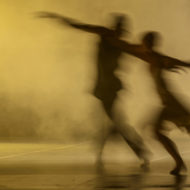
The “dynamosphere” is a three-dimensional model of effort relationships. Laban chose a cube for depicting effort kinships. Cate Deicher and I will be exploring these relationships in the forthcoming workshop, “Expanding the Dynamosphere.
Many people are familiar with the way Laban positioned the eight basic actions (floating, gliding, pressing, punching, etc.) at each of the eight corners of the cube. Whimsically, Laban likened this effort model to a “town with a good many cross-roads and squares between houses in which the effort microbes live.” … Read More









